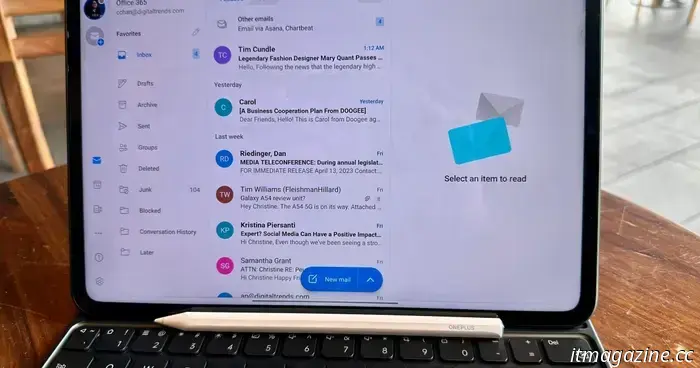
Classic Outlook will soon be more user-friendly in Windows 11.
Christine Romero-Chan / Digital Trends
Microsoft will soon simplify the experience for Windows 11 users who want to use classic Outlook without having to switch between applications. As reported by Windows Latest, this update is expected to roll out starting mid-May to alleviate user dissatisfaction with the new Outlook.
At present, users must toggle in the new Outlook to switch back to the classic version, which can be seen as inconvenient. In response to this feedback, Microsoft has stated that beginning in mid-May 2025, the new Outlook will minimize when users return to the classic version. The icon for the minimized app will remain visible on the taskbar, and any notifications or reminders from the new Outlook will cease.
In June 2025, Microsoft plans to implement an even more significant enhancement. Users will no longer need to use the toggle in the new Outlook; they will be able to launch the classic Outlook app directly, just like any other application, eliminating the need for the switching procedure.
Microsoft aims to finish this rollout by late July 2025, ensuring these changes are accessible to all Windows 11 users. This means moving forward, users can select their preferred Outlook version effortlessly, without manual switching or interruptions.
These updates are expected to greatly ease the burden on users who frequently alternate between the two Outlook versions. Until now, transitioning between classic Outlook and the new Outlook disrupted workflow, leading to frustrations for those who favored the familiar interface of the older app.
Currently, users can only switch by manually clicking the toggle button in the new Outlook to revert to the classic version, which can be both disruptive and time-consuming, particularly for those who require different features from both applications throughout the day. However, it remains unclear whether the new Outlook will continue to operate in the background, consuming system resources, or if it will enter a sleep state when minimized. Microsoft has also encouraged users to explore the new Outlook, emphasizing its ongoing feature updates and enhancements.
Judy Sanchez is a Digital Trends computing writer focusing on all computing news. She enjoys all operating systems and devices.
Copilot is Microsoft’s opportunity to improve Windows and surpass macOS
There will always be a noticeable division between macOS and Windows, largely due to fundamental differences in functionality at the operating system level. In heated community discussions, this often boils down to a contrast between seamlessness and flexibility.
For Windows supporters, gaming continues to be the primary attraction. Certain highly specialized tools also remain exclusive to the Microsoft platform. Conversely, macOS enthusiasts appreciate the smooth software experience, abundant power options with M-series silicon, and excellent hardware.
Windows 11’s debated AI Recall feature is set to arrive on your Copilot+ PC very soon
As AI advances, it inevitably integrates into our personal devices, with technology companies rolling out new features that rely on accessing private information and media to enhance user experience. While some may find this helpful, others could consider it invasive. One such feature is Microsoft's contentious AI Recall, which captures screenshots of your activity on a Copilot+ PC, making it easier to retrace your steps and find specific items later. After being announced last year and facing several delays, Recall is finally on its way to a larger audience of Windows 11 users.
Microsoft has recently confirmed Recall's arrival on Windows 11 with the latest Release channel update, build 26100.3902 (KB5055627). The feature's initial availability in the Windows 11 Release Preview channel, which follows the Beta channel in the Windows Insider program, indicates that it is beginning to roll out to a broader group of Copilot+ PC owners. This category of PCs currently includes a variety of laptops equipped with specialized hardware, such as a neural processing unit (NPU), designed specifically for AI tasks, and we may soon see desktops join this group.
Windows 11 and 10 users discover a new 'inetpub' folder after April update
Users of Windows 11 and 10 have reported encountering a mysterious 'inetpub' folder after installing Microsoft's April 2025 updates, as highlighted by Bleeping Computer. Although this folder is usually linked to the Internet Information Services (IIS) web server, it has begun appearing on systems that do not have it installed. Microsoft has confirmed that this behavior is intentional but has yet to fully explain the reasoning behind it.
The unexpected folder is empty and can be found in the root of the C: drive, regardless of whether IIS is installed. If IIS were installed, it would utilize the inetpub folder for log storage, website content, and server-related files. Therefore, it is unusual to have the folder without IIS after applying the Windows 11 KB5055523 update or Windows 10 KB5055518. The new inetpub folder is owned by the SYSTEM account, indicating it was created by an elevated process.





Other articles
 Sonos and Ikea end their collaboration on Symfonisk speakers.
Sonos and Ikea have opted to terminate their collaboration on wireless speakers.
Sonos and Ikea end their collaboration on Symfonisk speakers.
Sonos and Ikea have opted to terminate their collaboration on wireless speakers.
 Instacart aims for its new app to become an essential tool for gatherings.
Instacart has introduced a party food and drinks app tailored for Gen Z and Millennials, aptly called Fizz.
Instacart aims for its new app to become an essential tool for gatherings.
Instacart has introduced a party food and drinks app tailored for Gen Z and Millennials, aptly called Fizz.
 Is Gears of War: Reloaded compatible across different platforms?
It's time to gear up your lancers and head back to the game that began it all, but you'll need allies to overcome the Locust. We can clarify whether the new Gears of War: Reloaded supports cross-platform play.
Is Gears of War: Reloaded compatible across different platforms?
It's time to gear up your lancers and head back to the game that began it all, but you'll need allies to overcome the Locust. We can clarify whether the new Gears of War: Reloaded supports cross-platform play.
 A$AP x Star Wars? Discover which rapper tried out for the role of Lando Calrissian.
Prior to Donald Glover landing the role in Solo: A Star Wars Story, this Grammy-nominated artist auditioned for the part of Lando Calrissian.
A$AP x Star Wars? Discover which rapper tried out for the role of Lando Calrissian.
Prior to Donald Glover landing the role in Solo: A Star Wars Story, this Grammy-nominated artist auditioned for the part of Lando Calrissian.
 This 1990s fantasy film starring Sandra Bullock and Nicole Kidman is set to receive a sequel.
Warner Bros. has revealed the release date for Practical Magic 2, the follow-up to the 1998 fantasy film featuring Sandra Bullock and Nicole Kidman.
This 1990s fantasy film starring Sandra Bullock and Nicole Kidman is set to receive a sequel.
Warner Bros. has revealed the release date for Practical Magic 2, the follow-up to the 1998 fantasy film featuring Sandra Bullock and Nicole Kidman.
 Hisense discounts: The C2 4K Mini Projector is currently available at a $300 reduction.
The Hisense C2 4K Portable Mini Projector is currently available for $1,700 this week. You can take advantage of this price by purchasing it at Amazon or B&H Photo-Video.
Hisense discounts: The C2 4K Mini Projector is currently available at a $300 reduction.
The Hisense C2 4K Portable Mini Projector is currently available for $1,700 this week. You can take advantage of this price by purchasing it at Amazon or B&H Photo-Video.
Classic Outlook will soon be more user-friendly in Windows 11.
Microsoft is set to allow Windows 11 users to open classic Outlook directly without needing to switch, simplifying the retention of the older application.
